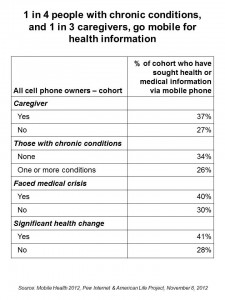
The ubiquity of mobile phones, increasingly smart ones (one-half of all mobile phones in the U.S. ), means people are walking around, working, playing and driving with self-tracking devices and ultra-mini computers in their pockets and totebags. 52% of smartphone owners seek health information on their phones, and overall 1 in 3 people seek health information on all mobile phones — nearly doubling the percent of those seeking health info via mobile in 2010 (17%). People who are sicker, caregivers, and those who have had a big change in health are also more prone to using phones for health, as the chart shows.
Welcome to the update of Mobile Health 2012, from the guress who brings you the most useful and rigorous data on the use of the Internet in health: Susannah Fox of the Pew Internet & American Life Project. (Disclaimer: while I earnestly wax lyrically about the quality and utility of Fox’s work, and I also consider her a friend).
Younger people, especially those under 50, tend to search health information via mobile more than those over 50: 42% of people 18-29, 39% of people 30-49, 19% of those 50-64. and 9% of folks 65+ are mhealth info seekers. People of color (35% of Black people, 38% of Hispanics) are more likely to surf for health information via phone compared with whites (27%). Nearly all demographic groups have increased use of mhealth info seeking except for people 65+ and those who didn’t finish high school.
Socioeconomics is generally positive skewed toward mhealth info seeking: those with college, with over $50K household income are more likely to do mobile health search.
The lightbulb moment here is that the sicker you are, the more likely you would be to use your cell phone, smart or function phone, to look up health information online. The chart clearly illustrates this point.
Texting for health remains very limited: while 80% of people across all age groups regularly text, only 9% of people text for health: 9% of women, 6% of men. It’s the middle age cohorts that health-text more: 10% of people 30-49 and 9% of people 50-64. Caregivers are also much more likely to use texting for health at 11%, and 10% of people with at least one chronic condition text for health.
mHealth apps seem to have flatlined in adoption, with 19% of all people having downloaded at least one mHealth app: 23% of women and 16% of men. Younger people tend to have downloaded a health app compared with seniors, 10% of whom have downloaded a health app. The most popular mhealth apps address exercise, diet/food and weight apps:
- 38% of health app users track exercise,
- 31% track diet
- 12% use apps to manage weight.
- 7% track menstrual cycles
- 5% track blood pressure.
Methodology: Pew interviewed 3,014 U.S. adults via landline and cell phone in August and September, in English and Spanish. The research was underwritten by the Pew Charitable Trusts and the California HealthCare Foundation.
Health Populi’s Hot Points: Fox has said that cellphones are de facto trackers. Since virtually everyone on the plane has a cellphone, it follows that ‘everyone’ should be able to self-track health. Currently, more women than men are self-tracking via mHealth, and seeking health information via phones. More affluent and educated also engaged more with mHealth via phone.
However, when one gets sick, or is managing a chronic condition or caring for someone else’s health, these are motivators to engage in mHealth based on the Pew survey. These are powerful moments-of-truth for individuals facing health challenges. They are also moments-of-opportunity for health marketers to support people in their health journeys.
Stakeholders seeking to change peoples’ health behaviors — whether health provider, health plan, pharmaceutical manufacturers or employer providing health benefits — have the opportunity to impact peoples’ health where they live, work, play and pray via the mighty cellphone, whether smartphone (via app) or full function phone (via text). Texting for health appears to be under-utilized based on the Pew survey, which is an opportunity to reach people with simple, compelling health messages to take medications, walk away from the computer screen, or engage in 20 minutes of meditation for a stressed cardiac patient.
The Pew data on the Internet and health continue to provide a mine of thinker-toys for those of us engaged in driving behavior change in health care. Thanks to the Pew Trusts and CHCF for continuing to fund this important research, and to Susannah Fox and Maeve Duggan of the Pew Internet project for their cogent analysis.




 I'm in amazing company here with other #digitalhealth innovators, thinkers and doers. Thank you to Cristian Cortez Fernandez and Zallud for this recognition; I'm grateful.
I'm in amazing company here with other #digitalhealth innovators, thinkers and doers. Thank you to Cristian Cortez Fernandez and Zallud for this recognition; I'm grateful. Jane was named as a member of the AHIP 2024 Advisory Board, joining some valued colleagues to prepare for the challenges and opportunities facing health plans, systems, and other industry stakeholders.
Jane was named as a member of the AHIP 2024 Advisory Board, joining some valued colleagues to prepare for the challenges and opportunities facing health plans, systems, and other industry stakeholders.  Join Jane at AHIP's annual meeting in Las Vegas: I'll be speaking, moderating a panel, and providing thought leadership on health consumers and bolstering equity, empowerment, and self-care.
Join Jane at AHIP's annual meeting in Las Vegas: I'll be speaking, moderating a panel, and providing thought leadership on health consumers and bolstering equity, empowerment, and self-care.